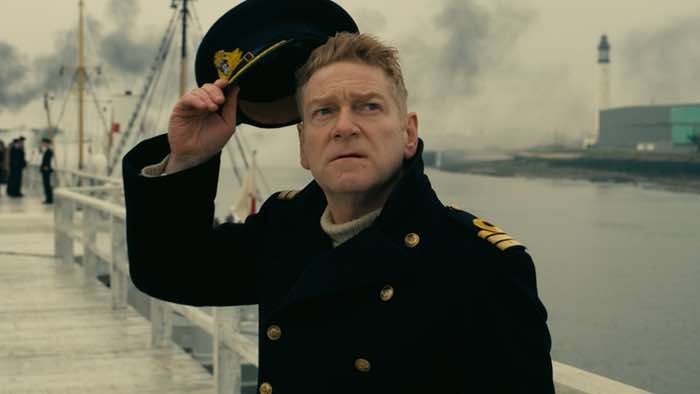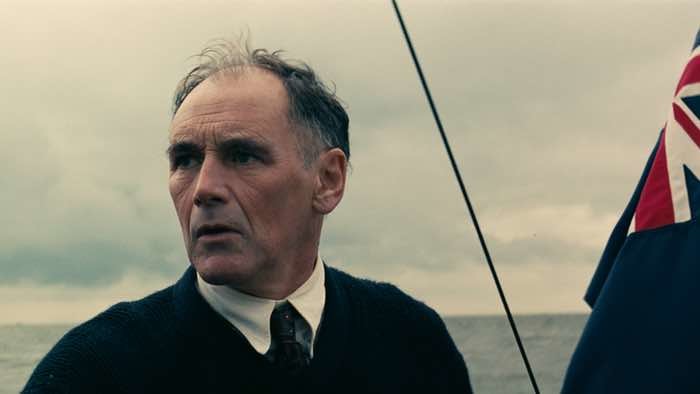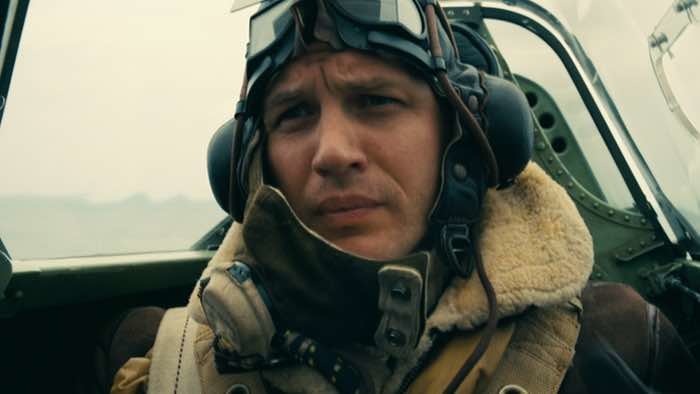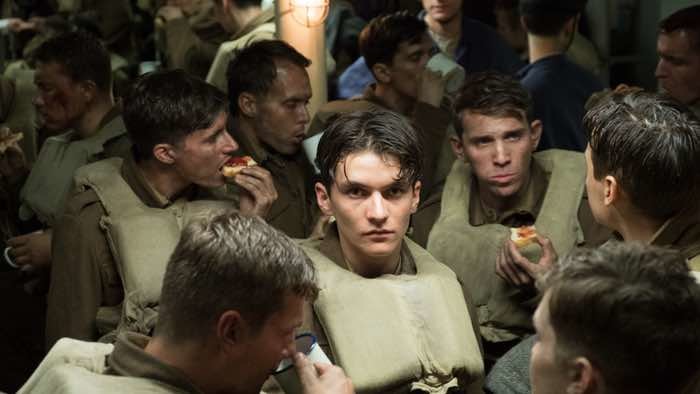'Dunkirk' Spoiler Review: Never Surrender
(In our Spoiler Reviews, we take a deep dive into a new release and get to the heart of what makes it tick...and every story point is up for discussion. In this entry: Christopher Nolan's Dunkirk.)In Christopher Nolan movies, the clock is always ticking.Time is a precious commodity, and it's also a luxury that the characters who inhabit Nolan films do not have. With his tenth film, Dunkirk, Nolan applies his favored ticking clock narrative to its fullest, crafting arguably his best film, or at least the film that most exemplifies his considerable talents. It's also in a way a rebuff of the criticisms that have dogged many of his films up until this point – if you thought some of Nolan's films before Dunkirk were too exposition-heavy, here is a film with almost no exposition to speak of. If you believed his previous movies lacked emotion or feeling, witness this: a film that is relentlessly tense and harrowing, concluding with a moment of perfectly rendered emotional triumph. It seems hyperbolic to throw the "masterpiece" designation around so soon after a film is released, but if Nolan's Dunkirk isn't officially a masterpiece yet, time may eventually fully reward it that distinction. The clock is ticking.
The Mole
"What I wanted to do was use the physics, use the geography...the main events, the movements and try to put those together as the backbone and the basis of the storytelling," Nolan says of the film in The Making of Dunkirk. "So the film is designed to be experiential; the characters that arise from that, the fictional stories we follow...they're really there to guide you through the geography of events."Dunkirk opens almost like a dream, awash in unreality and uncertainty. A group of British soldier wander the seemingly deserted French seaside town of Dunkirk, their backs to the camera, their identities a mystery. It's May 1940, nine months after World War II began. The German army has invaded France, cutting off the British and French armies, stranding 400,000 men along the French coast. These British soldiers wander the much-too-quiet streets, their guard seemingly down as papers drift down from the sky like strange snowflakes. The German's are dropping these propaganda leaflets – ominous warnings to the British troops that they're situation is hopeless. "WE SURROUND YOU" screams the text on the leaflets, complete with black arrows representing the German forces all pointing toward the shores of Dunkirk. "SURRENDER + SURVIVE!"Before we have a chance to learn who any of these wandering British soldiers are, they're slaughtered. Gunfire begins, picking them off one by one. They fall dead and unnamed in the streets, as only one scrambles to safety. This is Tommy (Fionn Whitehead), who escapes the carnage by diving over a barricade set up by other British soldiers. Tommy wanders beyond the barricade, down a narrow street, and comes out to a sight that catches both him and the audience off guard – the ocean is here, cold and gray and vast beyond a beach choked with men. Troops have been ordered to wait on the shore for evacuation across the channel.Home is only twenty-six miles away. It seems almost comically close, yet to the troops waiting on the shores of Dunkirk it's a distance stretching across a gulf of eternity. Because as they wait, defenseless, the German Luftwaffe are free to dive-bomb them into oblivion. The Germans come in piloting their single-engine Stuka planes – planes that emit a terrifying wailing siren, like the shrieking of demons.We're less than ten minutes into Dunkirk, and Nolan has already made clear the fact that this is a film that will refuse to relent. There's no peace here, no respite. Death is a constant, driving force, pushing the players around like pieces on a chessboard. Hovering just beyond all that death is home – so close and yet so far. "You can almost see it," several characters say throughout the film, gazing across that wide blue gulf.Nolan, a fan of twisty narratives that play with the concept of time, sets Dunkirk across three distinct locations and storylines. "The Mole", for the soldiers stuck on the beach, set over a period of one week. "The Sea", with characters racing towards the beach to lend assistance, taking place over one day. And then "The Air", with two Spitfire pilots cruising the sky above over a timeline of an hour. Unlike Nolan's previous films, Dunkirk is an ensemble narrative – there's really no main character here, but instead a group of people scattered across the story all with one common goal: survival.Tommy is the closest we come to a main character, but like almost all the characters in Dunkirk he remains mostly unknown to the audience. It doesn't matter who he is, or where he's from. All that matters is where he's trying to go – away from Dunkirk. While Germans bomb the beach, Tommy runs for cover, and encounters Gibson (Aneurin Barnard), another soldier burying a body in the sand. There's very little dialogue in Dunkirk, which keeps the film lean and also benefits a sort-of twist late in the film involving Gibson. The character never says a word for almost the entire film, yet because the dialogue is so sparse and the understood bond between Tommy and Gibson is so simple and effective, we almost don't notice. Because Gibson is actually a French soldier posing as British, wearing the dog tags of the British soldier he was burying when Tommy first encounters him.A third soldier joins Tommy and Gibson in their quest to get the hell off the beach – Alex, played by former One Direction singer Harry Styles. Alex is the more confident of these three soldiers, or least the one better at pretending he's confident. Tommy seems impossibly young – too young to be at war, and Gibson appears almost shell-shocked. Alex, however, is almost at home among all the chaos. It's a veneer that will eventually crack.Try as they might to get off the beach, the three soldiers inevitably end up back there. Tommy and Gibson pose as medics, carrying a wounded man to a hospital ship, as the wounded are being evacuated first. It's an action that has terrible consequences after a dive-bombing sinks the ship, all but ensuring the injured man they carried on board has drowned as the ship disappears beneath the murky waters. Later, when Tommy, Gibson and Alex end-up on board another ship, a torpedo sinks it, resulting in one of the most harrowing sequences in Nolan's career. Anyone with a phobia of drowning might want to stay away from Dunkirk, as the prospect of such a painful death looms throughout the entire film. Nolan keeps the camera inside the ship as it floods completely, soldiers who were one minute enjoying tea and toast suddenly kicking and flailing for dear life, their cries muffled by water filling their lungs.Tommy, Gibson and Alex escape the sinking ship, but now they have only one place left to go: back to Dunkirk. To await rescue that seems more and more unlikely to come. Also on land are Commander Bolton (Kenneth Branagh) and Colonel Winnant (James D'Arcy), representing the navy and the army respectively. These two men oversee the ever-mounting tensions at Dunkirk, looking out at the sea, hoping for rescue but not very confident rescue will come. And if and when it does come, will anyone even still be left? The clock is ticking, after all.
The Sea
Unable to land bigger ships at Dunkirk, the British recruited an armada of privately owned smaller civilian boats to assist with rescue operations. Dunkirk represents this through the crushingly stoic Mr. Dawson, played to perfection by Mark Rylance. Rylance, a longtime stage actor who only recently started appearing in films. The actor brings a quiet dignity to all his roles, and Dunkirk may be some of his finest work to date. Mr. Dawson is quiet where others are loud, and he sails forward to Dunkirk knowing that death may await. Because it's the right thing to do.Accompanying him is his teenage son Peter (Tom Glynn-Carney) and George (Barry Keoghan), a young family friend. Aboard their boat the Moonstone, the three brave the waters and whatever dangers lurk ahead. In their journey they come upon a sinking ship with a solitary soldier (Cillian Murphy) perched upon its upturned hull.In true Nolan nonlinear timeline fashion, we're given two distinct glimpses of Murphy's character, who remains unnamed and is only credited as "Shivering Soldier." Our first encounter with him is when Mr. Dawson rescues him, pulling him aboard the Moonstone. It becomes apparent very quickly that the soldier is suffering from PTSD, or shell shock, as Mr. Dawson refers to it. Having survived a torpedo attack, the Shivering Soldier is reluctant to go below deck of the Moonstone. After all, it's easier to escape a sinking vessel if you're already above the water. Later, however, Dunkirk goes back to the events taking place over a weeklong period back by the beach. Here, we see Murphy's character before the sinking of the ship – he's confident, even cocky. "You see two very different characters," Murphy said, "and I guess he sort of represents the profound effect that war can have on an individual's mental state."The Shivering Soldier is at odds with Mr. Dawson and company almost from the start. Yet while a lesser film may have turned the character into some sort of antagonist, Dunkirk remains compassionate, even after terrible things happen. So averse to returning to Dunkirk is the Shivering Soldier that he ends up causing a skirmish aboard the ship, resulting in a terrible injury to George. After George is injured, the soldier recedes into the background, cowering in a corner of the boat, a haunted, damaged soul. Peter is understandably angry with the soldier for his actions, yet by Dunkirk's end he's come to find sympathy and pity for the frightened man.Rylance is the rock that anchors these scenes. Like most characters in Dunkirk, he says very little, yet he exudes this almost unimaginable stoic goodness, resulting in one of the greatest characters in Nolan's entire oeuvre. "My story is a distillation of the story of thousands of men who went over with their brothers or sons — some women as well — on their pleasure boats to take part in the rescue and return the soldiers stuck on the beach," Rylance told THR. "It's an example of civilian bravery in a violent situation...I would hope that people take encouragement in that, that no matter how inconsequential or powerless they may feel — and we can feel it so easily these days as a normal civilian — that, actually, small actions make a big difference."The "Sea" sequence in general is the most emotionally resonant of the entire film, mostly removed from the horrors of the beach yet just as perilous. The air, meanwhile, is where the action waits.
The Air
"The Air" sequences of Dunkirk are the most literal representations of Nolan's much-favored "ticking clock" narrative. While "The Mole" and "The Sea" are set across a week and a day, respectively, "The Air" takes place just over the course of an hour. The timeframe is compressed, and the concept of time running out is represented by the constant burning of fuel.In the air, two Spitfire pilots – Farrier (Tom Hardy) and Collins (Jack Lowden) – engage in dogfights against the German Messerschmitts, who seem to materialize from nowhere at times. During several battles set breathtakingly against the wide-open sky, both Farrier and Collins' planes are damaged. Collins eventually has to make an emergency landing on the sea, a decision that leads to another terrifying near-drowning sequence as the pilot becomes trapped in his cockpit as water floods in. He's rescued at the last minute by the crew of the Moonstone, who happen to be near by when the plane ditched into the sea.Farrier, meanwhile, remains airborne, fighting off more planes whenever they should materialize. However, his fuel gauge has been damaged to the point that he can't be 100% sure how much fuel he has left. Sooner or later, it will run out. Like the passage of time, it's inevitable.Dunkirk is not a traditional war film – there aren't the type of thrilling ground battles that audiences have come to expect from the cinema of World War II. The only truly action-based sequences occur in the air, and even these are detached and economical. There's no hint of personal grudge in these sequences – the enemy is never truly glimpsed, save for their planes. Yet Nolan and cinematographer Hoyte van Hoytema create edge-of-your-seat scenes that quicken the pulse. The air-based gunfire is loud – you can practically feel it rattle in your head as the bullets cut through the sky. And that sense of ever-depleting fuel is always on the periphery. Nolan doesn't even need to cut to the damaged fuel gauge to drive this point home – we can sense it, and the anxiety that grows from it.Hardy has made a habit of hiding half of his face in certain roles, be it as Bane in Nolan's The Dark Knight Rises or as Max in Mad Max: Fury Road. The actor does it again here, most of his face hidden behind his flight mask. And once again, Hardy proves what a skilled actor he is by fully emoting behind such a mask. Of all the characters with few lines in the film, Hardy's Farrier has perhaps the fewest, yet he delivers a bravura performance through intense brow-furrowing based action. Hardy has incredibly expressive eyes, and he puts them to great use as he looks out from the cockpit of his plane.Some of Dunkirk's most powerful moments come from Hardy's scenes, such as near the end, when his plane has finally run out of fuel and yet he continues to glide through the air over the beaches. There's an eerie silence to these scenes, as we've grown so used to the rumbling of the engines. These are moments of serenity mixed with the anxiety of knowing that sooner or later, this fuel-less plane will have to come down.And it eventually does, with Farrier landing on a mostly empty beach as the sun sinks into the horizon, resulting in stunning magic hour imagery of Hardy standing by his burning plane, waiting for unseen German soldiers to come capture him. Because while the day may be ending, the war goes on.
"We Shall Never Surrender"
The Germans are never seen in Dunkirk. When they're referred to at all, they're referred to as "the enemy." They represent an almost supernatural force, unseen, unnamed, dangerous. Because Nolan isn't making a movie about Germany or the Nazis, he's making a movie about an always-churning tide that fights back against fascism.The victories in Dunkirk may not seem like great ones. There are no big battles fought on a grand cinematic scale. And while death is always looming, there's a bloodlessness to Dunkirk that almost seems at odds against other war films. Yet Nolan isn't watering things down – war remains hellish and harrowing even as the body count remains low.In some regards, Dunkirk isn't even really a war film. It is a film about perseverance. Rylance's Mr. Dawson is the true representation of the film's spirit – someone assessing the damnable odds and going forward anyway.Eventually, Tommy and Alex find their way back to England. Gibson isn't so lucky, drowning after yet another boat sinking. His death is heartbreaking and almost entirely off-camera, yet the weight of it is felt tenfold. Death and time are interwoven, inevitable. Always ticking out.Some of those returning felt like failures. They were, after all, retreating, and few people look upon retreat as victory. But living may be a victory in and of itself. When Tommy and Alex are boarding a train to take them away from the waterfront, an old man commends them for their bravery. "All we did was survive," Alex says, not feeling particularly heroic. "Sometimes that's enough," replies the old man."They really thought people would be angry with them and frustrated with them because they had been defeated," Nolan says. "[B]ut they found the opposite. The true victory that is snatched from the jaws of defeat is in the spirit of Dunkirk."Nolan likes to end his films with weighty montages – someone intoning a speech in voice over set several shots of the film's surviving characters at different points of time. With Dunkirk, the filmmaker has the benefit of not having to write the speech himself, but rather using a powerful one from history. Following the events of Dunkirk, Prime Minister Winston Churchill was able to craft a parliamentary speech to check the national mood while appealing to the United States to join the war."I have, myself, full confidence that if all do their duty, if nothing is neglected, and if the best arrangements are made, as they are being made, we shall prove ourselves once again able to defend our Island home, to ride out the storm of war, and to outlive the menace of tyranny, if necessary for years, if necessary alone. At any rate, that is what we are going to try to do," Churchill said, his words here recited by Tommy. "We shall go on to the end...we shall fight on the seas and oceans, we shall fight with growing confidence and growing strength in the air, we shall defend our Island, whatever the cost may be, we shall fight on the beaches, we shall fight on the landing grounds, we shall fight in the fields and in the streets, we shall fight in the hills; we shall never surrender."Dunkirk is not precisely a film about our current times, yet it speaks to them, across the span of history. Hope is a hard thing to come by, and even harder to keep hold of once you snare it. It can wriggle free like something greased. At times, it can even seem like holding out for hope is a fruitless endeavor. What's the point, if darkness continues to prevail? Yet the overwhelming theme of Dunkirk is to continue on anyway. To "rage against the dying of the light", to quote the Dylan Thomas poem that Nolan used so frequently in Interstellar. The message is clear: against insurmountable odds and the specter of annihilation, the human spirit will prevail. We will never surrender.
